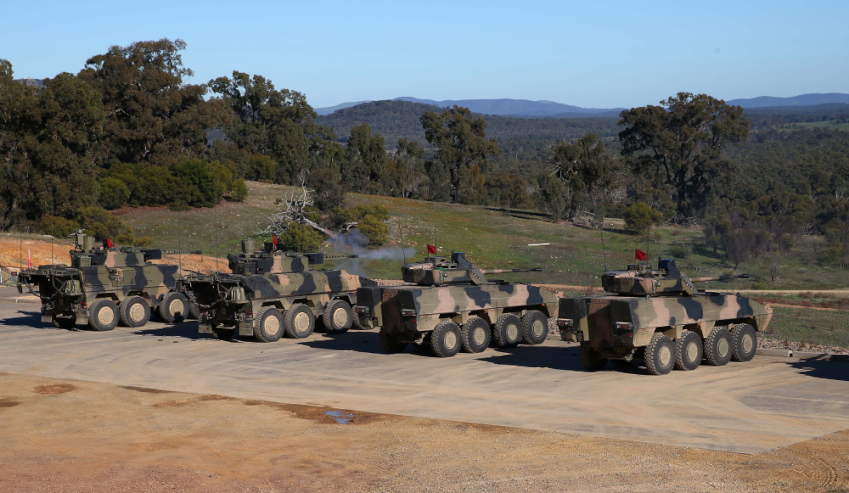When British academic and defence specialist Martin Shaw talks about the ‘new Western way of war’, what he’s referring to is force protection. Armies, learning the lessons of the 20th century, have adapted strategies, tactics, and technologies to help keep our soldiers, airmen and sailors safe.
That key consideration is written into the DNA of Phase 2 of the LAND 400 project, which is to select Australia’s new combat reconnaissance vehicles (CRVs). The two remaining contenders vying for the $5 billion project are the BAE Armoured Modular Vehicle (AMV35) and Rheinmetall’s Boxer. Both are heavier and stronger, and have greater firepower than their predecessor, the Australian Light Armoured Vehicle (ASLAV).
The LAND 400 project is an excellent case study of the challenges associated with Defence’s focus on force protection. Both the Boxer and the AMV35 have much more firepower – a 30mm and 35mm cannon respectively, as well as space for two guided missile launchers. More firepower means more weight, and while both options boast heightened lethality, both can store fewer rounds and missiles than the ASLAV.
But the real weight increase comes from the armour and the scaling up of all the systems designed to make the vehicles safe and functional. Since the introduction of the ASLAV in the 1990s, the roadside bomb or IED became a common tool used by asymmetric adversaries. As such, the ADF has placed emphasis on strengthening the armour around the tyres and on the undercarriage of whichever vehicle it chooses. Both options weigh more than double the ASLAV, which means that Australia’s C-130 Hercules aeroplanes will be hard pressed to transport more than one or two of them at a time.
For some, like Ben Coleman of the Australian National University’s Strategic and Defence Studies Centre, the increased weight of whichever contender wins the LAND 400 contract could limit the ADF’s operational freedom.
"They’re certainly not air portable,” Coleman told Defence Connect, “and it raises issues around how many can be carried by the landing craft that go into our LHD’s [Amphibious Assault Ships], then there’s another potential problem in terms of the transport infrastructure that exists around the theatre."
Coleman says that while the Boxer and the AMV35 are suitable for major coalition operations, they will also be used to contribute to the security of our neighbourhood. Something which, he says, requires a far more agile force due to the poor nature of the roads and other transport infrastructure throughout much of our region.
"Both contenders for the LAND 400 Phase 2 have battlefield mobility that is equal to or better than the ASLAV, but vehicle weight and size is still a negative factor for strategic deployability; for example strategic airlift in a crisis or ability to use poor roads without degrading those roads, and weight limited bridges," Coleman said.
The federal government’s obsession with force protection, Coleman argues, is an understandable one, and he concedes that there is no right or wrong answer to the choice between protection and strategic deployability.
He suggests that "a trade-off has to be made but this requires a really well-developed understanding of capability need. Defence seems to be optimising for protection and firepower over strategic deployability and logistical supportability, but this choice is less well suited to crisis reaction and stabilisation operations in our neighbourhood".
Nick Stewart, Canberra Times columnist and writer, suggested to Defence Connect that the best way for the Australian Army to meet both its obligations to the missions it undertakes and to the men and women who serve, is to understand those missions totally. He argues that the conception of the proposed CRV is outdated.
"The trouble is, what we’re doing now is replacing an armoured reconnaissance regiment that was originally designed for operations on the German border," Stewart said.
"We’re never going to have a central front in Europe that we’re going to participate in, and instead we require new formations and new ideas that can appropriately engage in our region."
He suggested one way of using the strengths of the new vehicles without sacrificing force protection or mission effectiveness was to use them as a sort of mobile base.
"One of the things about the Rheinmetall armoured vehicle is it’s way too heavy. For example, it can’t get up hills. It can’t sit at the top of the hill and look at things. But it will be very secure, it will protect people, and they can operate little remote aircraft from that vehicle, so effectively you get to the top of the hill without having to go there physically," Stewart said.
That kind of secure operating base for unarmed aerial vehicles, he argues, will provide a far greater picture of the battlespace than the CRV could on its own, enhancing the mission effectiveness of a vehicle that is specifically designed for reconnaissance.
Coleman agrees that the Australian Defence Force needs to be thoughtful when it comes to deciding which vehicle it chooses and what it will be used for.
"For a very small army, like the Australian army is always going to be, then you really ought to be focusing as far as you can on being clever about it and using an indirect approach rather than crossing directly into the teeth of fire," he said.
Whichever vehicle ultimately wins the Phase 2 LAND 400 contract, Australia’s new CRVs will be stronger, heavier and deadlier, but also safer for the men and women who will utilise them on the ground. Because questions remain over the strategic deployability and mobility of both vehicles, the ADF will have to be clever and considered in how they’re used if missions are to be successful without sacrificing force protection.
That said, it may well be that when Australia’s fleet of C-130J cargo planes is retired around 2030, the conversation we have to then focus on is how many Boxers or AMV35s the next generation of aircraft can hold, something which will contribute to Australia’s ability to deploy them in a crisis.



